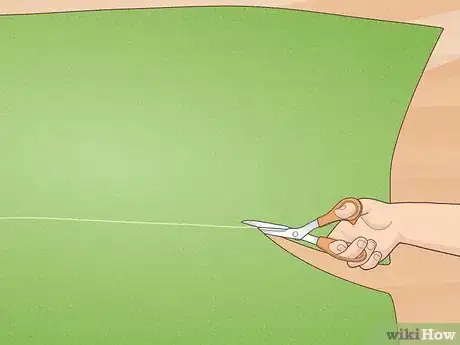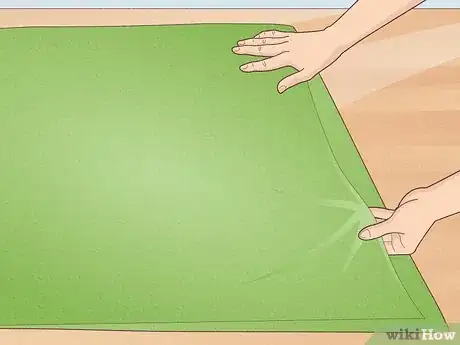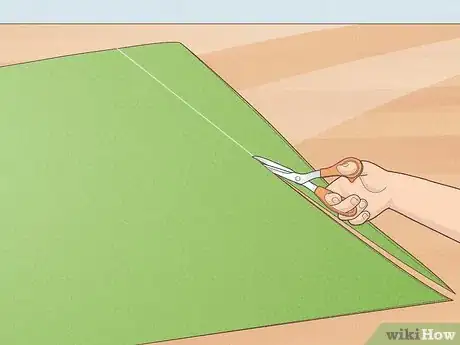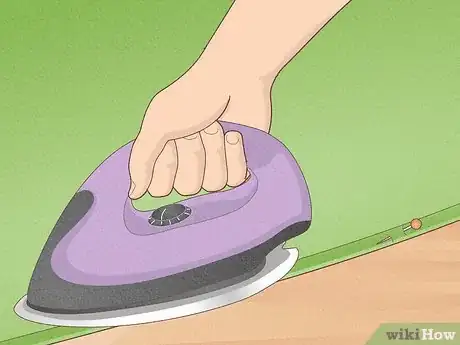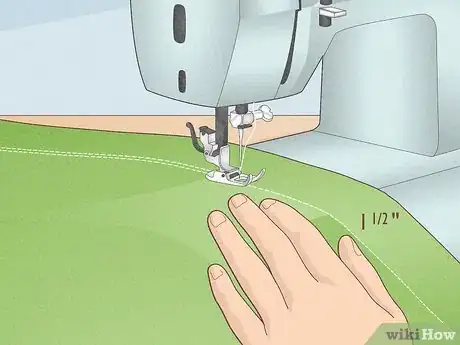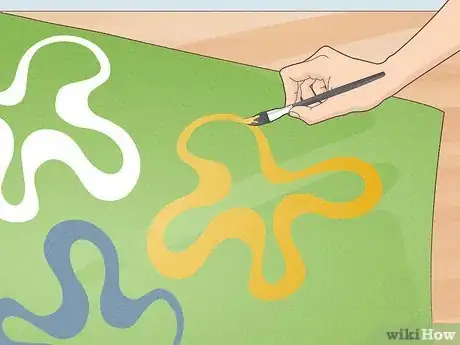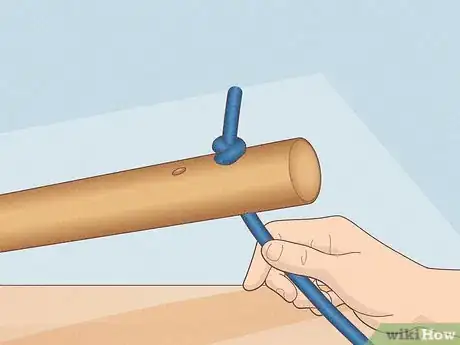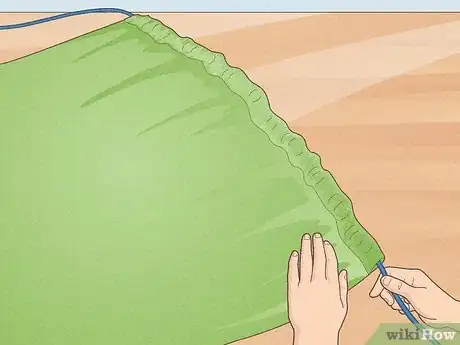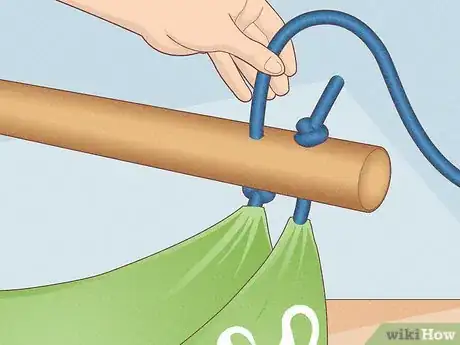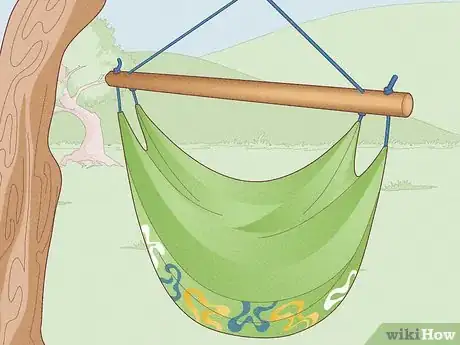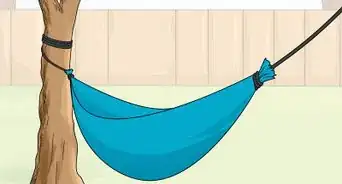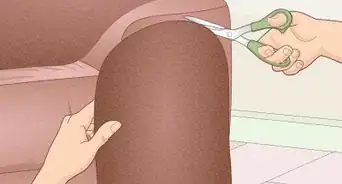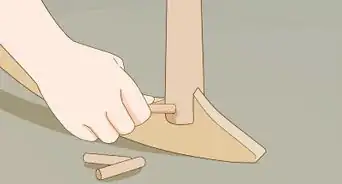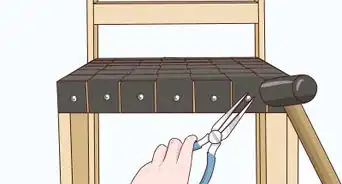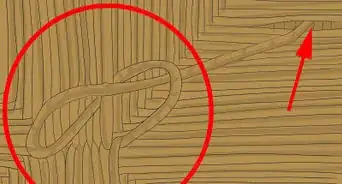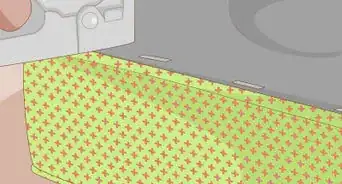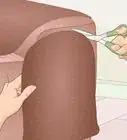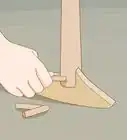wikiHow is a “wiki,” similar to Wikipedia, which means that many of our articles are co-written by multiple authors. To create this article, 12 people, some anonymous, worked to edit and improve it over time.
This article has been viewed 251,916 times.
Learn more...
Making a hammock chair is a straightforward DIY project that will leave you with a cozy spot to relax indoors or outside. These chairs are perfect for adding a unique element to any room or for an outdoor spot that isn't big enough for a full hammock. Best of all, making one for yourself guarantees that you'll have the perfect size, shape, and color to match your furniture. For this project you'll need several basic materials and a good chunk of time in order to get it done correctly. Once it's finished, you'll have a hammock chair that is sure to impress anyone who sits in it!
Things You'll Need
- 1 ¼”x3’ oak dowel
- 3/8”x16’ braided polypropylene
- 2 yards (1.8 m) plain canvas
- 80mm stainless steel spring snap link
- 3/16” stainless steel quick link
- Fabric paint (of your choice)
- Paint brush
- Drill with 3/8” drill bit
- Sewing machine
- Iron and ironing board
- Sharp scissors
- Ruler
- Lighter
- Hanging hook
Steps
Preparing the Canvas
-
1Cut canvas for the seat. Canvas seats can be made to fit any size person, or project. For a small child, 2 yards (1.8 m) of the canvas will be appropriate, while adults will need 3-4 yards of fabric to form a proper seat. Most canvas should come at a standard width of 1.75 yards.[1]
- If you want a deeper chair, fold the canvas long-ways, making your cuts along the longer edges of the fabric. If you want your chair wider, cut along the short side. In general, the short-side cut makes a better chair.
-
2Fold the full piece of canvas in half and lay it flat. Fold the canvas in half, short-ways. Orient the folded edge to your left. Mark a point about 7 inches to the left of the top right corner and draw a light diagonal line with pencil, toward the bottom right corner. This is where you'll cut.
- Again, make sure the folded edge is oriented to your left. You want to cut the unfolded side of the fabric.
Advertisement -
3Cut along the line using sharp fabric scissors. Go slowly, taking care to avoid creating a raggedy edge to work with. If you do, don't worry too much, because you can fold it over later while you're assembling and creating the edges. Open up the canvas and spread it out to work.
- You should have a four-sided shape, with two angled edges of equal length, a long side and a short side. Orient the fabric so the shortest side is at the top.
-
4Hem each edge of the fabric. Fold each edge back half an inch, then fold it again and iron. Pin them in place, and then stitch the fold twice in two parallel lines to reinforce it. Hemming the top and bottom of the chair seat will help to prevent tearing after frequent use.
- Hem the diagonal edges as well, but only once. After hemming the long and short sides, fold the diagonals that you cut earlier about a half inch, as you did the other edges. Pin, press, and sew the edge to reinforce it.
-
5Sew 1 ½” pockets on each diagonal side. Fold an inch and a half pocket back on each hemmed diagonal edge, then iron. Sew two reinforced lines along the hem, creating a pocket seam large enough to pull the rope through.
- Reinforce your beginning and ending with back stitches. These pockets are going to be holding your weight, so they need to be secure.
-
6Design the canvas with fabric paint. Get creative and use your fabric paint to express yourself through your hammock chair. To prevent a mess, consider placing your canvas on a large sheet of cardboard.
- Consider painting both sides as you will see the back and bottom of the chair.
- Allow for ample dry time before proceeding to next step.
- You can also use printed fabric, but be sure it is upholstery weight or outdoor fabric to ensure its strength.
Attaching the Seat
-
1Drill four holes through the dowel. Mark two holes at each end of the dowel, at 2” and 4”. Then drill through the holes using your 3/8" bit. Sand the hole to remove any little burrs and clean up the drilling. If you like the natural wood tone, you can leave it or, you can stain the dowel if desired.
-
2Knot one end of the rope and guide it through the canvas pocket. Tie a large knot at one end of the 16’ rope, leaving about 3” of a tail beyond the knot. Using a lighter, you can also melt the end of the rope slightly to prevent fraying in the long-term.
- Start threading the unknotted end through the dowel and canvas. Guide the down through the outer hole in the dowel and then up from the widest corner of one side of the canvas seat to the narrow corner at the top.
- Measure approximately 3 feet from your first knot, and tie another knot. Thread the rope up through the inner hole of the dowel so that the knot you just tied rests against the bottom of the dowel (the opposite side as the first knot).
-
3Thread the rope back through the other side of the canvas. Start by threading it down through the 4” (or inside) hole on the other side of the dowel. Measure 3 feet from the loose end and tie a loose knot. This knot will rest against the bottom of the dowel. Thread the loose end of the rope down though the other canvas pocket, starting at the narrow end and emerging from the wider end.
-
4Finish threading the rope. Guide it up through the last hole in the dowel. Measure 3” from the loose end and tie a knot, leaving a 3” tail. This knot will rest on the outside of the dowel. When finished, the knots should be positioned on the dowel.
- If the two lengths of rope hanging below the dowel are not even, adjust the knots as needed before pulling them tight.
-
5Hang the chair. Find the center of the rope above the dowel and tie a knot with 8” to 10” of excess above it. Attach the spring link, and then your quick link to the excess rope above the knot. Screw the hanging hook into a ceiling beam or large tree branch that can support your weight, then hang the link from it.
Community Q&A
-
QuestionWould doing this be easy, hard or time consuming?
 Community AnswerIf you study up on how to do it beforehand, and have all of the materials you'll need ready, it should take a couple of hours at most. Just be sure to use materials that can support a bit more than the weight of the heaviest person you think will be using it.
Community AnswerIf you study up on how to do it beforehand, and have all of the materials you'll need ready, it should take a couple of hours at most. Just be sure to use materials that can support a bit more than the weight of the heaviest person you think will be using it. -
QuestionWhat is the weight limit for a hammock chair?
 Community AnswerIt depends on the strength of your materials. Since most of the force exerted on the dowel will be a compression force, the dowel recommended in this article will hold most people (and even two people at once). Canvas is usually very strong too. If you're concerned that your chair might not support as much weight as you want it to, try using a thicker dowel or sewing together 2 layers of canvas before starting the project. Using a thick, durable thread and stitching carefully will also improve the strength of the chair. Finally, remember to test the chair's strength before putting your full weight on it!
Community AnswerIt depends on the strength of your materials. Since most of the force exerted on the dowel will be a compression force, the dowel recommended in this article will hold most people (and even two people at once). Canvas is usually very strong too. If you're concerned that your chair might not support as much weight as you want it to, try using a thicker dowel or sewing together 2 layers of canvas before starting the project. Using a thick, durable thread and stitching carefully will also improve the strength of the chair. Finally, remember to test the chair's strength before putting your full weight on it! -
QuestionMy canvas is 60" wide and I have 2 yards (72"). In the tutorial I'm using on abeautifulmess.com, the fabric does not look anything like these dimensions. How do I know I'm using the right materials?
 Community AnswerIn this article, 1.75 yards (or 63") is considered standard. That's just a little wider than the fabric you have. Two yards of 60" wide canvas should be plenty of fabric to make a child's chair. For an adult's chair, double that length (four yards total).
Community AnswerIn this article, 1.75 yards (or 63") is considered standard. That's just a little wider than the fabric you have. Two yards of 60" wide canvas should be plenty of fabric to make a child's chair. For an adult's chair, double that length (four yards total).
About This Article
To make a hammock chair, cut the canvas to the desired size to create the seat. Fold each edge back half an inch, fold it again, and stitch the fold with 2 parallel lines to hem the canvas. Next, sew pockets on each diagonal side. Then, drill 4 holes through the dowel, guide the rope through the canvas pocket, and thread it through the holes to secure the canvas. Finally, tie off the rope with a knot and hang the chair from a ceiling beam or large tree branch that can support your weight. For more tips on hanging your chair securely, read on!
